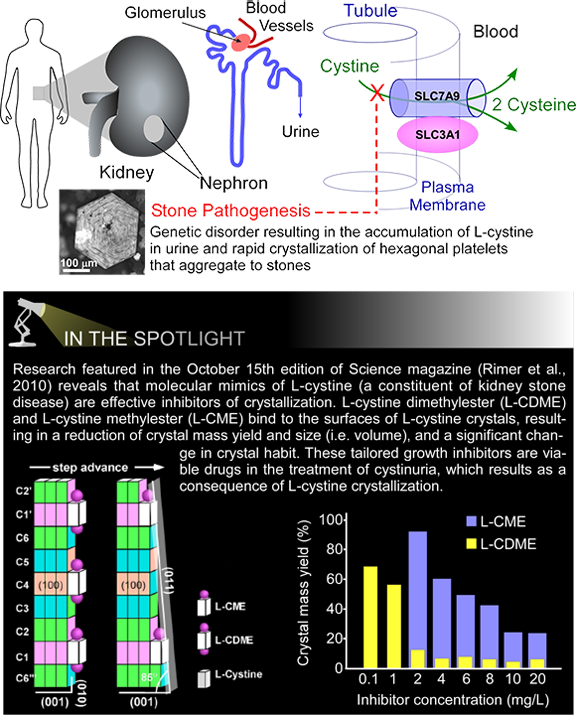
Research Overview
Research initiatives in the Rimer group employ colloidal and interfacial techniques to design, characterize,
and model the growth and self-assembly of crystalline materials. There are three general areas of research (microporous materials, biomineralization, molecular design) that focus on the formation of a broad range
of materials that span applications in catalysis, separations, drug discovery, and bio-inspired design.
These projects are linked together by common themes and objectives that include:
- Understanding the mechanism of materials formation at a molecular level
- Measuring anisotropic growth of materials using scanning probe microscopy
- Quantifying molecular recognition at crystal interfaces
- Developing predictive models to selectively tailor crystal growth and properties
The following sections provide more detailed descriptions of each research project.
Microporous Materials
Rational Design of Zeolites
There are over 170 unique crystal frameworks of zeolites with a range of nanopore diameters and
dimensionalities that are ideal materials for shape-selective catalysis and selective separations. Research
in the Rimer Group seeks to understand the mechanism of materials formation at a molecular-level
toward the development of growth models that can a priori tune crystallization with predictable
structural outcomes. Initiatives in our group collectively aim to design zeolites with optimal crystal habit
through novel synthetic approaches and controlled anisotropic growth. The ultimate goal is to transform
zeolite synthesis from an art to a science with long-term impact in a range of applications with both
commercial and socioeconomic importance.
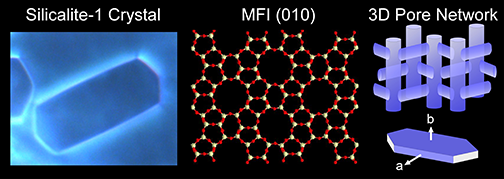
Interfacial Studies of Zeolite Crystallization
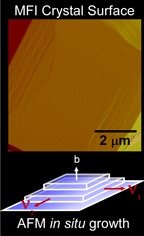 Research initiatives in the Rimer Group use scanning probe microscopy to characterize the topography of zeolite surfaces and to measure in situ growth
Research initiatives in the Rimer Group use scanning probe microscopy to characterize the topography of zeolite surfaces and to measure in situ growth
(i.e. advancement of steps on the surface in real time). Understanding growth
at a near-molecular level allows us to quantify anisotropic kinetics and to better understand crystal growth mechanisms and building units, which has been a subject of much interest. Moreover, characterizing zeolite topography is critical for understanding how surface features correlate with catalytic activity. Along these lines, we are integrating these studies with collaborative initiatives to design, characterize, and test zeolites for many types of reactions.
The following project on de-NOx processes highlights one of these thrusts,
wherein we seek to uncover structure-property relationships that govern zeolite performance in these applications.
Selective Catalytic Reduction of NOx
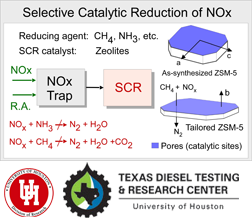 Zeolites are viable catalysts for the reduction of greenhouse gas emissions in both lean burn and diesel vehicles. Selective catalytic reduction (SCR) of NOx is an area of ongoing research at the University of Houston through the Texas Diesel Testing and Research Center (TDTRC). Synergistic research thrusts in the Harold and Rimer Groups (UH Department of Chemical & Biomolecular Engineering) have taken a full-scale approach to the development of this technology. These initiatives include (i) the design of new zeolite synthetic schemes to produce catalysts with improved performance, (ii) the testing of SCR catalysts with bench-scale and on-board vehicle reactors, and (iii) the modeling of reaction kinetics.
Zeolites are viable catalysts for the reduction of greenhouse gas emissions in both lean burn and diesel vehicles. Selective catalytic reduction (SCR) of NOx is an area of ongoing research at the University of Houston through the Texas Diesel Testing and Research Center (TDTRC). Synergistic research thrusts in the Harold and Rimer Groups (UH Department of Chemical & Biomolecular Engineering) have taken a full-scale approach to the development of this technology. These initiatives include (i) the design of new zeolite synthetic schemes to produce catalysts with improved performance, (ii) the testing of SCR catalysts with bench-scale and on-board vehicle reactors, and (iii) the modeling of reaction kinetics.
Back to top of page
Biomineralization
The Rimer Group is interested in several physiological processes of biomineral self-assembly, which
include vascular calcification and kidney stone disease. Research projects on the latter are part of a
collaborative effort with medical doctors aimed to study disease pathogenesis and design therapies
with improved efficacy. Kidney stones are polycrystalline aggregates that are comprised of several
components. Our group focuses on the most prominent constituent, calcium oxalate monohydrate
(COM). The processes leading to stone formation are not well understood, but involve four critical
pathways: crystal nucleation, crystal growth, intercrystalline aggregation, and crystal and/or aggregate
retention. Research thrusts are directed toward the characterization of nucleation and growth at
variable reaction conditions, using light scattering and scanning probe microscopy to quantify the
kinetics of crystallization. Moreover, we are interested in understanding the role of urinary constituents,
such as proteins and lipids, in the formation of single crystals and polycrystalline aggregates. Several
ubiquitous proteins are associated with COM stone disease, and can either serve as stone inhibitors
or promoters. A molecular-level understanding of what distinguishes the role of proteins in stone
pathogenesis is lacking, yet it is widely believed that such knowledge can be critical for the design of
therapeutic treatments and novel drugs with higher efficacies for preventing kidney stone formation.
Research thrusts in our group also focus on a rare case of stone disease caused by a genetic disorder
in amino acid transport, wherein the amino acid dimer L-cystine accumulates in the kidney and readily crystallizes and forms stones through the four critical pathways mentioned above. These studies seek to improve our understanding of the disease pathogenesis and to design rational treatments to suppress the formation of L-cystine stones, which are highly reoccurring and debilitating.
Rational Design of Drugs for Malaria Treatment
Collaborators: Prof. Peter Vekilov, U.H. Chemical Engineering
Malaria is one of the most dangerous infectious diseases in developing countries, affecting more than 40 % of the world’s population and causing between 1 and 3 million deaths per year. Scientific advancements in antimalarial drug discovery during the past century have mirrored military campaigns in regions where the disease led to significant casualties. Substantive progress has been made in the identification of antimalarial drugs, although their efficacy, compatibility, and high cost limit their effectiveness and/or availability. Malaria negatively impacts world economies and human health. Notably, it affects U.S. military personnel serving in regions with high risk of infection. Moreover, the resistance of malaria parasites to antimalarial drugs poses serious health concerns for widespread growth of the disease. As such, there is a need for more concerted efforts in the fields of m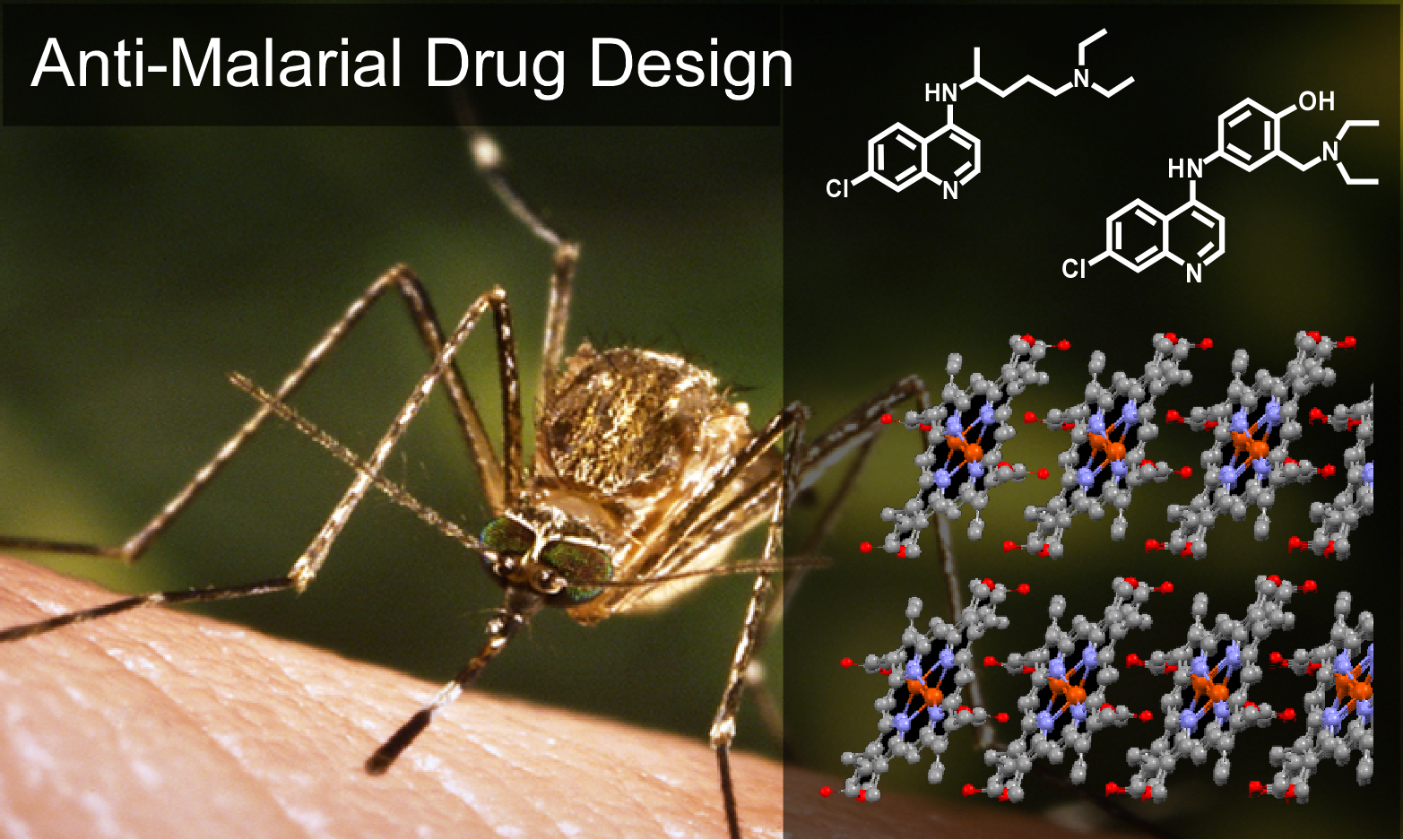 edicine, engineering, and the physical sciences to develop new drugs capable of overcoming these challenges.
edicine, engineering, and the physical sciences to develop new drugs capable of overcoming these challenges.
The goal of our investigations is to develop a rational approach for antimalarial drug discovery capable of circumventing conventional time-intensive and costly high-throughput methods. Research initiatives focus on the characterization of hemozoin crystallization and inhibition at a near molecular level using scanning probe microscopy.
Back to top of page
Molecular Design
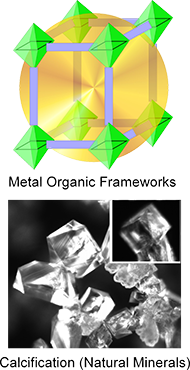 The Rimer Group has several projects involving the rational synthesis of inorganic materials through molecular design, wherein we are interested in fundamental interactions at crystal interfaces. Biomineralization, for example, is facilitated by the association of proteins and other biological constituents with the mineral interface. Molecule-substrate interactions are dominant factors that control crystal habit (i.e. orientation, shape, and size). As such, initiatives in our group seek to examine molecular adsorption at crystal surfaces and quantify its effect on materials growth. To accomplish this we use combined experiments (e.g. atomic force microscopy) and molecular modeling (via collaborations with partnering groups). The adsorption of biomolecules on mineral surfaces can significantly influence their structural properties; thus, by developing an improved understanding of molecular recognition at crystalline interfaces we can use this information to selectively tailor materials for diverse applications.
The Rimer Group has several projects involving the rational synthesis of inorganic materials through molecular design, wherein we are interested in fundamental interactions at crystal interfaces. Biomineralization, for example, is facilitated by the association of proteins and other biological constituents with the mineral interface. Molecule-substrate interactions are dominant factors that control crystal habit (i.e. orientation, shape, and size). As such, initiatives in our group seek to examine molecular adsorption at crystal surfaces and quantify its effect on materials growth. To accomplish this we use combined experiments (e.g. atomic force microscopy) and molecular modeling (via collaborations with partnering groups). The adsorption of biomolecules on mineral surfaces can significantly influence their structural properties; thus, by developing an improved understanding of molecular recognition at crystalline interfaces we can use this information to selectively tailor materials for diverse applications.
Back to top of page

